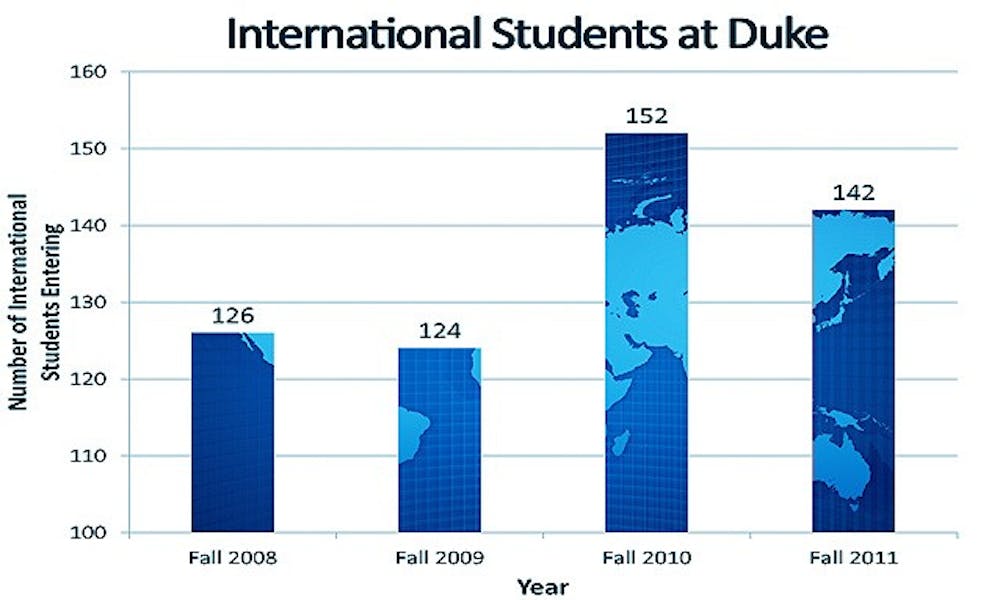Duke is expanding its reach internationally— and the same can be said for admissions.
For years Duke lagged behind its peers in international recruitment, Dean of Undergraduate Admissions Christoph Guttentag said. The University’s decision to offer need-based financial aid to international students ten years ago, however, has since caused the number of international applicants—and eventual students—to significantly increase.
With 142 students representing 55 countries, the Class of 2015 features one of the largest numbers of international students in the school’s history, Guttentag said.
International admissions experienced a yield rate similar to the University’s overall yield of 44.3 percent this year, he added, noting that China and Canada are the countries most represented. The yield for international students was more than 10 percentage points lower in 2003, at 36 percent.
“The increase among international students is one of the most significant changes I’ve seen at Duke in the last 20 years,” Guttentag said. “It’s been gratifying to see how our visibility and appeal internationally have grown. International students add texture and talent to the class that make for a better undergraduate experience for everyone.”
The rise in international students can be, in part, attributed to the addition of this aid, he noted.
But despite the University’s decision to offer aid to international students, the admissions process for them is not need-blind.
“We are need-blind for citizens and permanent residents, but we are not need-blind for international students,” Alison Rabil, assistant vice provost and director of financial aid, wrote in an email Wednesday. “So there is an opportunity for international students to come to Duke with aid, however, that aid is much more limited for international students than it is for citizens and permanent residents.”
Rabil noted that she does not know of any plans to change this policy in the future.
Since the University’s decision to offer need-based financial aid to international applicants in 2002, Duke has steadily attracted more international students, Guttentag said. At first, the increase was steep—from 700 applicants in 2001 to 1,200 in 2002—but now it is more gradual, with between 100 and 200 more students applying each year. Currently, about eight percent of undergraduates are international.
Recruiting efforts internationally are still an important work in progress for the University, Guttentag said.
“One of the difficulties has been that its difficult to do recruitment overseas because its logistically demanding and its expensive,” he said. “We don’t travel internationally to recruit as much as we would like or as much as some colleges do.”
He added, however, that recruiting for athletics internationally, bringing counselors from international schools to campus and remaining close with international alumni are three ways the University builds relationships with the international community.
Some international students, however, said they believe Duke still has some work to do in the area of name-recognition, especially in comparison to its American peer institutions.
“Few Swedes have heard of Duke,” said junior Felix Wibergh, of Sweden. “Most who have heard of Duke work in international companies or are otherwise internationally oriented. I and a few others are trying to change this and make Duke more well-known in Sweden.”
Junior Talia Glodjo, of Canada, said she felt similarly.
“[Duke] is not well-known where I am from, especially because it is a Southern school, and basketball isn’t a big college sport [in Canada],” she said. “The Ivy League [schools are] better known.”
But for the international students that make it to Durham, Guttentag said the University tries to give international students as smooth a transition as possible.
International House Director Li-Chen Chin said she believes the organization has played a significant—though indirect—role in recruiting international students and helping them to suceed.
“When students have great experiences, they and their family members are most likely recommending Duke to others who are interested in pursuing a world-class education,” she said.
Guttentag added that one of the best ways Duke is increasing its name recognition abroad is through word-of-mouth.
“It is extremely beneficial when one or two students from a school or city come to Duke and have a good experience,” he said. “Then the word travels fast that this is a good place to study, a good place to be educated.”
Guttentag added that Duke is currently searching for ways to increase the University’s name recognition, such as engaging its international alumni in the admissions process to a greater extent than it currently does. Ultimately, international students come to Duke or other American universities because they recognize the quality of an American education and the unique opportunities they offer, he noted.
“If a student chooses to study in the United States from overseas they know that it is going to be a different kind of experience than studying in their home country,” Guttentag said. “They have made a conscious decision to pursue a different kind of education. And to those students, Duke is a pretty terrific choice.”
Get The Chronicle straight to your inbox
Signup for our weekly newsletter. Cancel at any time.

